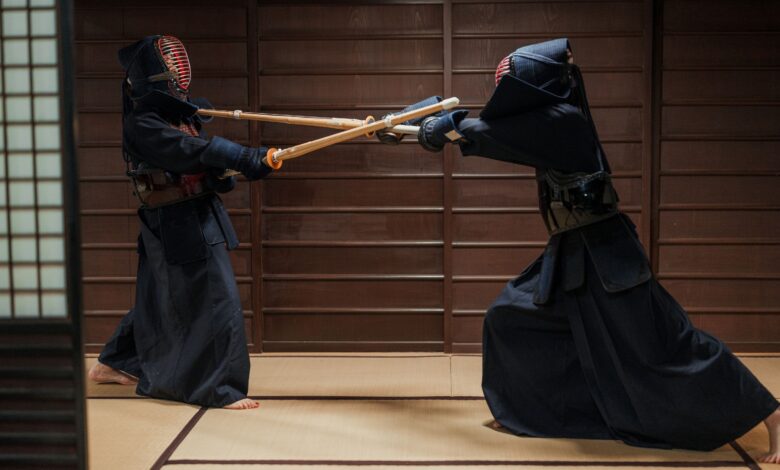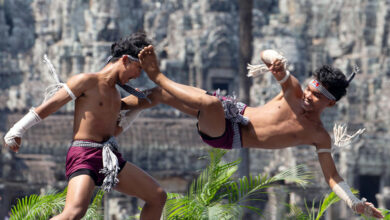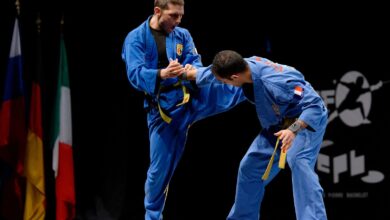Kendo: The Way of the Sword

Martial Arts: Kendo (剣道), meaning “The Way of the Sword,” is a modern Japanese martial art that evolved from traditional samurai swordsmanship. It is practiced worldwide as both a competitive sport and a discipline focused on mental, physical, and spiritual refinement. Kendo combines the use of bamboo swords (shinai) and protective armor (bogu) to simulate combat, preserving the essence of the samurai warrior while adapting it for modern practice.
This article explores the origins of Kendo, its transformation through Japanese history, its spread globally, and its significance today.
Origins: Samurai Swordsmanship and Kenjutsu
The Birth of Kenjutsu (Pre-19th Century)
Kendo traces its roots to Kenjutsu (剣術), the traditional art of Japanese sword fighting used by samurai warriors. Kenjutsu techniques were developed for battlefield combat, emphasizing cutting, thrusting, and defensive maneuvers. Samurai warriors trained in Kenjutsu as part of their bujutsu (武術, warrior skills) to prepare for warfare.
During the Muromachi period (1336–1573) and the Sengoku period (1467–1600), Japan was in a state of constant warfare. Kenjutsu flourished during this time, with numerous ryu (流, schools) emerging, each with its unique philosophy and techniques. Famous Kenjutsu schools included:
- Itto-ryu (一刀流) – One of the most influential sword styles, known for its powerful strikes and simplicity.
- Yagyu Shinkage-ryu (柳生新陰流) – A refined style used by the Tokugawa shogunate’s official sword instructors.
- Shinkendo (真剣道) – A style that emphasized live blade (katana) training.
As Japan entered the Edo period (1603–1868), samurai no longer fought on battlefields, and Kenjutsu evolved into a means of personal refinement and self-discipline rather than survival.
Development of Modern Kendo
The Introduction of Protective Gear and Shinai (18th–19th Century)
During the early Edo period, Kenjutsu practice often involved the use of real swords or wooden bokken, making training highly dangerous. To reduce injuries and allow for full-contact practice, Japanese sword masters introduced:
- Shinai (竹刀, bamboo sword) – A flexible weapon designed to safely simulate a katana.
- Bogu (防具, protective armor) – Comprised of a helmet (men), chest protector (do), gloves (kote), and waist protector (tare), allowing for safer sparring.
These innovations were primarily developed by Naganuma Shirōzaemon Kunisato (長沼四郎左衛門国郷) in the 18th century, enabling a more dynamic and practical form of sword training.
Meiji Restoration and the Decline of Kenjutsu (1868–1900s)
The Meiji Restoration (1868) led to the abolition of the samurai class, and the government banned the wearing of swords in public. As a result, Kenjutsu and other martial arts suffered a decline, being viewed as outdated relics of the past.
However, the late 19th century saw efforts to revive and modernize traditional swordsmanship. Samurai descendants and martial arts enthusiasts worked to reestablish Kenjutsu as an educational discipline, focusing on spiritual and physical development rather than military application.
The Birth of Kendo (20th Century)
Formation of Kendo as a Sport and Discipline
By the early 20th century, Kenjutsu evolved into a modern martial art known as Kendo. The term “Kendo” was officially adopted to distinguish it from its battlefield-oriented predecessor. In 1912, the Dai Nippon Butoku Kai (大日本武徳会, Greater Japan Martial Virtue Society) standardized Kendo techniques and training methodologies.
Kendo was introduced into Japanese police academies, schools, and military training, promoting discipline, respect, and perseverance. It became an integral part of Japan’s educational system, emphasizing values such as bushido (武士道, the way of the warrior).
Post-World War II Ban and Revival
After Japan’s defeat in World War II (1945), the Allied Occupation Forces banned Kendo and other martial arts, fearing they promoted militarism. However, in 1952, Kendo was reinstated as a non-militarized sport under the supervision of the All Japan Kendo Federation (AJKF). This marked the rebirth of Kendo as an international sport and discipline.
Kendo in the Modern World
Global Expansion
During the 20th and 21st centuries, Kendo spread beyond Japan, with federations established in Europe, the Americas, and Asia. Major governing bodies include:
- International Kendo Federation (FIK) – Established in 1970, organizing world Kendo championships.
- European Kendo Federation (EKF) – Oversees Kendo development in Europe.
- North American Kendo Federation (NAKF) – Governs Kendo in the United States and Canada.
Today, Kendo is practiced in over 60 countries, with regular international tournaments and grading examinations.
Philosophy and Principles of Kendo
Kendo is more than just a sport; it is a discipline that fosters self-improvement, mental resilience, and respect for tradition. Practitioners (kendoka) follow the concepts of Kendo, as established by the All Japan Kendo Federation:
- Kendo as the Cultivation of the Human Spirit – Emphasizing courtesy, honor, and lifelong learning.
- Strike with Ki-Ken-Tai-Ichi (気剣体一致, Spirit, Sword, and Body as One) – Ensuring that attacks are executed with spirit (ki), correct technique (ken), and body movement (tai) in perfect harmony.
- The Four Sicknesses of Kendo (Shi-Kei-Ku-Gaku, 四戒) – Avoiding hesitation (shikai), fear (kyoi), doubt (kui), and confusion (gaku).
Kendo fosters self-discipline and respect through structured training, bowing etiquette, and a deep connection to Japan’s samurai heritage.
Training, Techniques, and Competition
Fundamental Techniques
Kendo primarily involves strikes to four target areas using the shinai:
- Men (面) – Head strike
- Kote (小手) – Wrist strike
- Do (胴) – Torso strike
- Tsuki (突き) – Thrust to the throat (advanced level)
Training includes:
- Kata (形) – Traditional forms practiced with bokken.
- Kumite (組手) – Sparring matches to test technique and timing.
- Shiai (試合) – Competitive matches following strict point-based scoring.
Kendo has evolved from samurai battlefield combat to a highly respected martial art practiced worldwide. It preserves the philosophy, discipline, and spirit of the samurai, while also serving as a competitive sport and a path to self-improvement.
With deep roots in Japanese history, Kendo continues to inspire martial artists and remains a symbol of tradition, honor, and perseverance.



